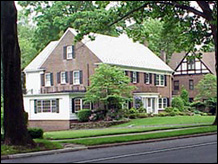|
|
|
|
|
|
|
|
|
|
|
|

|
| More and more Americans are taking out interest-only mortgages. Is this a recipe for a financial disaster? |
Play video
|
|
|
|
NEW YORK (CNN/Money) -
When bond yields compete with Martha Stewart and Bernie Ebbers for headlines, they usually lose. But recently they've gotten attention by behaving in a way that has sparked fears of a big economic slowdown.
That's because the yield curve has been flattening. The graph of bond yields in the Treasury market usually slopes upward, with yields on longer-term bonds higher than shorter maturities.
Some experts even say there's a decent chance the curve may soon invert -- an event that has preceded the nation's last two recessions. (Confused about yield curves? Click here for help.)
Federal Reserve Chairman Alan Greenspan is worried, too, calling the persistence of low long-term rates a conundrum.
He and other Fed policy-makers have raised a key, short-term interest rate, the fed funds overnight bank lending rate, to 3.25 percent from 1 percent just over a year ago, as the central bank tries to ward off inflation, and cool off the housing market, while it keeps economic growth on track. (Full story.)
But while short-term rates have risen, long-term rates, which are set by the markets, haven't followed suit. In fact, the yield on the 10-year Treasury is about half a point lower than it was last June.
That, in turn, has helped keep mortgage rates low, since home loan rates track the long-bond rate. And some, including Greenspan, have begun to worry that the red-hot housing market may overheat. (Full story.)
Analysts said the Fed's power to influence long-term Treasury and mortgage rates has been clearly diminished by a number of factors -- most notably low inflation worldwide and the growing clout of foreign central banks on U.S. rates through their purchases of Treasury bonds.
Investors usually sell Treasuries on signs of economic strength, or when short-term rates start rising, as they bet that long-term rates will eventually rise along with inflation. (Bond prices and yields move in opposite directions).
But most bond investors and economists say the 10-year yield probably won't rise much further this year -- even though the Fed probably isn't through raising short-term rates.
And while that will leave the yield curve flat, or perhaps inverted, some experts are saying the curve is not as good a recession predictor as it once was.
"It's not inaccurate to say that Fed concerns about bond yields have been overdone," said Steve Rodosky, vice president at Pacific Investment Management Co. (PIMCO), one of the world's biggest bond investors.
Low inflation: bonds party on
One big reason long bond yields have stayed low is that inflation has remained remarkably quiet, even with strong economic growth and record high oil prices.
Measured by the Consumer Price Index, the government's main inflation gauge, inflation was running at about 3.6 percent a decade ago, but that's been closer to 2 percent over the past five years, said Anthony Crescenzi, chief bond market strategist at Miller, Tabak & Co., an institutional brokerage. (The latest reading on June CPI shows inflation is tame. Click here for the full story.)
"We've had growth without inflation, said Crescenzi. "And every time the Fed raises rates it enhances its reputation as an inflation fighter," he said, noting that the central bank has convinced many bond investors that it's out in front on the fight against inflation.
As a result, he thinks the average yield on the 10-year Treasury will end the year at about 4.25 percent, just below the average for 2004.
"At the end of the day, if Greenspan wants to solve the conundrum of low long-term yields, then raising the fed funds rate is not the answer," said John Derrick, who handles $570 million in fixed income investments for U.S. Global Investors. "[Raising short-term rates] gives the long bond more staying power," he added.
Outsourcing the Fed
Then there's another school of thought that says the march of globalization has eroded the Fed's influence over long-term rates.
"Globally, the U.S. and some emerging markets are the leading growth engines," said John Herrmann, director of economic commentary at Cantor Fitzgerald, one of the world's top Treasury bond brokers.
And with growth slow in Europe and Asia, and rates relatively low worldwide, Treasuries have become unusually attractive for overseas investors -- for yield as well as perceived safety.
So the stronger the U.S. economy becomes relative to Europe and Japan, the lower long-term bond yields could fall as foreign banks keep snapping up Treasuries, analysts said.
Underscoring this point: foreign banks now own far more Treasury securities than the Fed, at about $1.1 trillion versus $738 billion for the central bank, according to Grant's Interest Rate Observer.
As the current state of affairs persists, the link between low long-term yields, a yield curve inversion and a possible recession becomes less clear.
"We buy foreign-made goods that are inexpensive and those countries plug our deficit by buying U.S. securities," PIMCO's Rodosky said. "Everyone playing that game wants to perpetuate that cycle because it is benefiting them."
To find out why Cantor Fitzgerald predicted an inverted curve, click here.
To read why Cantor said the curve may not happen, click here.
For more on the yield curve, click here.
To see what bonds are doing today, click here.
And for bond market charts, click here.

|